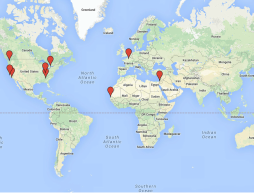|
Prawns Mean Business: Leveraging Aquaculture to Reduce a Disease of Poverty
The escape from schistosomiasis, a poverty-inducing infectious disease, may come in the form of an African freshwater prawn, a source of sustainable disease control and aquaculture revenue. Schistosomiasis doesn’t just kill – it traps. People living in poverty are more likely to contract the disease, which is caused by parasitic, water-borne flatworms. What’s more, the debilitating symptoms of infection can prevent people from working, thus creating a disease-poverty cycle. An Ecological Solution Research conducted by The Upstream Alliance, a global partnership of scientists specializing in disease ecology, health, aquaculture and development, indicates that the African river prawn could biologically control the parasite. In the scientific paper, published in Proceedings of the National Academy of Sciences, researchers studied two villages – both situated by the Senegal River, and both heavily affected by schistosomiasis. In one village, researchers stocked prawns in a water access point, and in the other village, they just observed the site. Over 18 months, they found that the first village experienced an 80% lower abundance of infected snails and a 50% reduction in the intensity of human schistosomiasis infections, measured as the number of flatworm eggs in a person’s urine or stool. “The results of our study open the pathway to a novel approach for the control of schistosomasis,” said Stanford professor of ecology Giulio de Leo. Why? Prawns are voracious predators of snails, which host schistosoma parasites before they enter humans. Prawns cannot become infected when they eat the snails, so more prawns means fewer parasite-carrying snails and fewer parasites in the water to infect people. A Business Opportunity Freshwater prawns are considered a delicacy, so the prawn business is more than a global health solution – it’s also a business opportunity. Senegalese fishermen have fished for prawns for centuries. But, in Senegal, the prawn population has hit a concrete wall – literally. The Diama Dam, constructed in 1986, blocked the downriver migration of prawns to breeding spots at the mouth of the Senegal River. More than that – the dam increased the aquatic vegetation along the river that schistosoma-hosting snails love. In such a favorable environment, and without an important predator, snail populations exploded. Schistosomiasis prevalence followed suit. Removing the Diama Dam is not an option. The dam sustains agriculture in Senegal and provides fresh water to hundreds of thousands of individuals. Luckily, there are other ways to help sustain a healthy prawn population, such as constructing a fish ladder. Yet another is prawn aquaculture – a viable and crucial alternative for the Senegalese. Initiatives such as Aquaculture Pour La Santé, a subsidiary of Biomedical Research Institute Espoir Pour La Santé (EPLS, the major Senegalese partner of The Upstream Alliance) are exploring opportunities to stock prawns in parasite-infested hotspots in the Senegal River Basin. This opportunity could open up a new realm of entrepreneurship and enhance food security in underdeveloped areas. EPLS CEO Dr. Gilles Riveau says, “It still needs a lot of brain storming, a lot of research, a lot of work to achieve a balanced, effective, and highly reproducible application of this strategy.” But, he says, prawns can create a “constant effect” on the reduction of schistosomiasis transmission in a sustainable way[GR1] . Connecting Research to Action Current efforts to control schistosomiasis in Senegal include large campaigns using the drug praziquantel, which kills schistosomiasis after people have become infected. Upstream Alliance researchers show that adding prawns to the mix through a two-pronged campaign could defeat the parasite in two stages of their life cycle: prawns clear parasites from the environment and drugs clear parasites from the people. “Our research shows that combining mass drug administration campaigns with snail predators could have a lasting effect on public health,” said Susanne Sokolow, the study’s lead author. Next steps for the project are currently under way within The Upstream Alliance. Plans include introducing prawns to more village water access points, researching a prawn passage on the Diama Dam, and exploring new technologies and markets for African prawn aquaculture. Riveau says, “Much of the scientific field work will take place in the low valley of Senegal river through EPLS Center, including selection of villages, medical and parasitological follow-up, [snail studies, and] prawn production [GR2] and stocking.” Sign up for the Upstream Alliance email list to stay up-to-date on project developments and news. Follow Upstream Alliance on Twitter, LinkedIn, and Facebook. Reference: Sokolow, Huttinger, Jouanard, Hseih, Lafferty, Kuris, Riveau, Senghor, Thiam, N’Diaya, Faye & de Leo. 2015. Reduced transmission of the human schistosomiasis after restoration of a native river prawn that preys on the snail intermediate host. PNAS. http://dx.doi.org/10.1073/pnas.1502651112 Contact Us: The Upstream Alliance, [email protected] Gilles Riveau, Biomedical Research Institute Espoir Pour la Santé, [email protected] Nicolas Jouanard, Biomedical Research Institute Espoir Pour la Santé, [email protected] |
The Upstream Alliance News and EventsNews feed about the activities, news, and events of The Upstream Alliance: Partners in Schistosomiasis Reduction Archives
August 2016
|

 RSS Feed
RSS Feed
